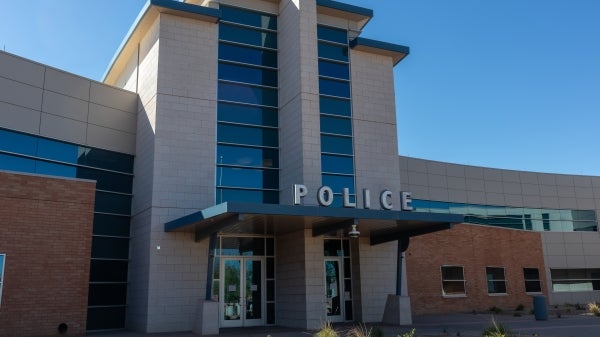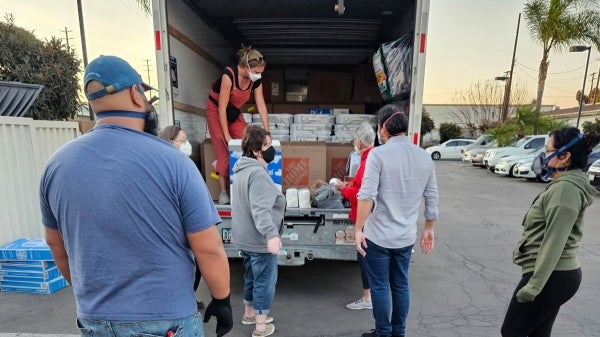Protecting national security in a rapidly changing world

Collage by Christian Van Bebber and Alec Lund
As the 21st century dawned, the challenges facing our nation and the world — such as cyberthreats, resource scarcity and space security — became too big to solve with traditional research methods. These problems called for a new, holistic approach and collaboration with the government and private sectors.
That’s why, in 2015, Arizona State University launched the Global Security Initiative (GSI) to serve as an interdisciplinary hub for research on complex global security issues.
In the years since, GSI’s research and education efforts have helped transform our capabilities in science and technology to meet defense, security and intelligence mission needs. But those needs, as well as the technology itself and our interactions with it, evolved dramatically over that time. GSI’s own evolution reflected those changes as it both anticipated and responded to the shifting global security landscape.
Now, in 2025, the initiative celebrates an impactful 10 years of advancing national security solutions.
A defining decade
The past decade has seen rapid technology advancements, including artificial intelligence, semiconductors and chips, wearables, the space economy, and personalized medicine. These developments have changed both our capabilities and our vulnerabilities, and they will continue to shape the way we live in the years to come.
“The fact that novel tech has penetrated society at large has created an appreciation of the need for interdisciplinary work,” says Nadya Bliss, executive director of GSI. “We are exceptional at this type of work, and I think we’re uniquely positioned to solve some of these very difficult problems.”
As technology and geopolitics have co-evolved over the past 10 years, the U.S. national security strategy has adjusted as well. The threat landscape has grown. In addition to geopolitical power competitions, Bliss says, we now face competition in areas with less defined rules of engagement — technology, information and outer space.
“The national security community has always been very technologically enabled and centered. The better tools we have, the more likely we're not going to go to war, because you can prevent a lot of conflict,” Bliss says.
Celebrating impact
One of GSI’s major contributions to the ASU community has been helping the university grow its engagement with U.S. Department of Defense. ASU has more than doubled its DOD-funded research expenditures since GSI launched in 2015.
“It’s been awesome for me to see researchers who have never worked with the Department of Defense before get to take on some of the most challenging problems impacting society that have applications for both national security and civilians,” Bliss says.
Nationally, GSI proved valuable in both anticipating and responding to global security challenges. Regular leadership sessions helped the initiative plan ahead for areas of focus and new centers to address emerging challenges. Bliss’s own leadership and engagement in various national committees also provided key insights and networks to guide GSI’s development, and vice versa.
“At GSI, we take deep pride in really listening to the needs of the national security community while also leveraging our understanding of advanced technology to understand what's on the horizon,” Bliss says.
GSI has become a global leader in addressing complex defense issues, not only advancing our understanding of global security but also contributing to making the world a safer place. I celebrate GSI’s accomplishments and look forward to its continued impact in the years to come.
Sally C. MortonExecutive vice president of ASU Knowledge Enterprise
To celebrate 10 years, we’ve compiled 10 major wins from GSI’s first decade:
- Bolstered homeland security and public safety: GSI conducted groundbreaking research to improve efficiency and security at national borders and airports through its Center for Accelerating Operational Efficiency (CAOE), a Department of Homeland Security Center of Excellence. Researchers also studied how to measure if an AI system is a trustworthy teammate.
Read more: Q&A with CAOE Director Ross Maciejewski - Protected vulnerable infrastructure: Researchers at the GSI Center for Cybersecurity and Trusted Foundations took a proactive, interdisciplinary approach to the issue of cybersecurity, a critical piece in protecting our nation’s infrastructure. In a DARPA-funded project, one team developed a tool to translate code and help engineers make minimally disruptive patches to legacy systems.
Read more: Q&A with CTF Director Adam Doupé - Advanced human-AI collaboration: GSI’s Center for Human, Artificial Intelligence, and Robot Teaming (CHART) synthesized research across computer science, robotics, law, art and social science. Successful human-machine systems could revolutionize national security, space exploration and medicine. The center’s researchers created the largest publicly available human-AI team research dataset in history using data generated through the video game Minecraft.
Read more: Q&A with CHART Director Jamie Gorman - Combated malicious influence: The Center on Narrative, Disinformation and Strategic Influence worked to identify and mitigate the impacts of strategic influence campaigns from foreign adversaries intent on undermining the interests and security of the U.S. and its allies. The Office of Naval Research awarded ASU a grant to examine thousands of mass media and social media postings in the Baltic states to help detect if Russia was planning a military invasion there.
- Provided training for the national security workforce: GSI helped create training for military intelligence soldiers at Fort Huachuca, Arizona, to serve as a primer on AI, machine learning and data science. To fill critical gaps in the cybersecurity workforce, GSI also offered research and learning opportunities to students in the NSF CyberCorps program at ASU. Students in the program receive a scholarship and in exchange commit to work in a cybersecurity position at a federal agency after graduation.
- Supported the next generation of faculty: ASU is among the top three universities in the nation for the total number of DARPA Young Faculty Awards. Fueling ASU’s success, GSI launched the DARPA Working Group in 2015 to help junior ASU faculty members pursue the career-boosting DARPA awards. Past recipients have worked on advanced imaging sensors, predicting autonomous drone swarm behavior and improving low-frequency military radios.
- Taught learners at every stage: GSI helped grow the skills of lifelong learners, from middle school students in Arizona to cybersecurity professionals in industry to seasoned experts in the Department of Defense. The Center for Cybersecurity and Trusted Foundations organized the world’s largest hacking competition at DEF CON, connected high schoolers with cybersecurity mentors through an innovative internship program, and is developing a new educational model for AI applications in cybersecurity.
- Engaged ASU in defense solutions: GSI catalyzed defense research across the university, growing technical strength areas through dedicated centers and supporting and amplifying the efforts of GSI faculty and other ASU units working on national security challenges. As ASU’s defense portfolio grew, it paved the way for the university’s most recent recognition: its selection to support the DOD Irregular Warfare Center.
- Created a new paradigm for defense research: GSI is a highly innovative organization in the defense research space because it works outside of traditional academic boxes. Its researchers bring many disciplines — engineering, social science, biology and more — to bear on complex problems. In one example, GSI researchers are developing autonomous systems to control groups of robots called “swarms,” modeled after social creatures like bees and birds.
- Engaged in and informed national priorities: Through its record of execution, GSI emerged as a leader in national security research and solutions, and its faculty are regularly appointed to national bodies dedicated to informing the direction of technological advancement. Bliss has been involved in the Computing Community Consortium for over seven years and began serving as its chair in 2024. She has also served as the chair of the DARPA Information Science and Technology Study Group and served on multiple National Academies committees.
Preparing for the future
While GSI aims to address current national security mission needs and drive advancements on pressing security priorities, it also prepares for the challenges of the future.
Moving forward, GSI will work with partners to expand its focus areas to meet the national security challenges of the moment — such as ensuring the energy resilience of defense missions, improving forensics to trace biological threats and advancing the security of U.S. capabilities in space. The initiative will also seek to meet the need for large-scale, updated training for the national security workforce, as well as ethical guidelines for emerging technologies like AI and quantum computing.
“I want to emphasize that it's about the people and the mission. I really care that the work is rewarding and impactful,” Bliss says. “The scale changed — it's different when there's three of you versus when there's a hundred of you. But throughout our 10 years of growth, I think we've stuck with those principles. Running and building this organization with the team here has been one of the greatest privileges and honors of my life.”
More Local, national and global affairs

Accreditation helps build exacting standards, public trust in law enforcement agencies, ASU professor says
Accreditation is a tool police agencies can use to help assure the public that sworn personnel adhere to high professional standards, says an Arizona State University professor who recently completed…

Trade tariff negotiations take many twists and turns
Making good on a long-held campaign promise, President Donald Trump has instituted tariffs on trade with China and threatened the same with Canada and Mexico.Citing unfair business trade practices…

More than 1,000 air filters delivered to LA wildfire survivors
As wildfires engulf large areas of Los Angeles, harmful particles and toxic gases from the smoke pose major respiratory health risks to Los Angeles residents. For Liesl McConchie, a board member…